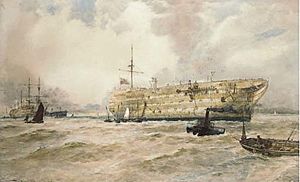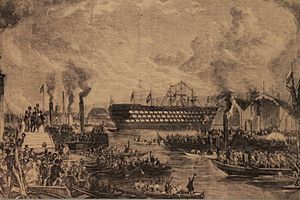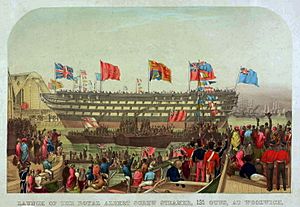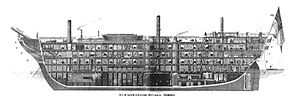HMS Royal Albert (1854) facts for kids
class="infobox " style="float: right; clear: right; width: 315px; border-spacing: 2px; text-align: left; font-size: 90%;"
| colspan="2" style="text-align: center; font-size: 90%; line-height: 1.5em;" | 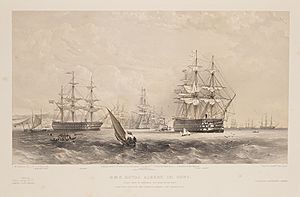
|}
The launch of HMS Royal Albertat Woolwich Dockyard in 1854.
Another view of the launch of Royal Albertin 1854.
HMS Royal Albert was a very large warship belonging to the Royal Navy. She was a "three-decker," meaning she had three main decks for guns. The ship was built at Woolwich Dockyard and launched in 1854. Interestingly, she was first planned as a sailing ship. But while she was still being built, engineers decided to add a new technology: a screw propeller. This meant she could move using steam power as well as sails!
Contents
| History | |
|---|---|
| Name | HMS Royal Albert |
| Ordered |
|
| Builder | Woolwich Dockyard |
| Laid down | August 1844 |
| Launched | 13 May 1854 |
| Completed | By 19 November 1854 |
| Decommissioned | 1861 |
| Fate | Sold to Castle for Breaking up, September 1884 |
| General characteristics As sailing ship | |
| Tons burthen |
|
| Length |
|
| Beam | 60 ft 10 in (18.54 m) |
| Depth of hold | 25 ft (7.6 m) |
| Sail plan | Full-rigged ship |
| Complement | 1000 |
| Armament |
|
| General characteristics After conversion | |
| Displacement | 5,517 tons |
| Tons burthen | 3,726 26/94 bm |
| Length |
|
| Beam | 61 ft (19 m) |
| Draught |
|
| Depth of hold | 24 ft 2 in (7.37 m) |
| Propulsion |
|
| Sail plan | Full-rigged ship |
| Speed | 10 knots (under steam) |
| Complement | 1,050 |
| Armament |
|
Building a Mighty Ship
The Royal Albert was ordered in 1842 as a sailing ship. However, by 1852, plans changed to include a steam engine and screw propeller. This was a big step forward for naval technology. She was finally launched on May 13, 1854. Lithographs (a type of print) from that time show her launch. They also mention that John Penn & Sons of Greenwich fitted her with the new screw propellers.
Life at Sea
After being finished, the Royal Albert was ready for duty.
- Early Commands: Her first commander was Alexander Little, from June to October 1854. Then Captain Thomas Sabine Pasley took over for a short time.
- Crimean War Service: From February 1855 to April 1857, Captain William Robert Mends commanded the ship. During this time, she served as the main ship (flagship) for Rear-Admiral Edmund Lyons. Admiral Lyons was in charge of the Mediterranean Fleet. Their main job was to help with the Crimean War.
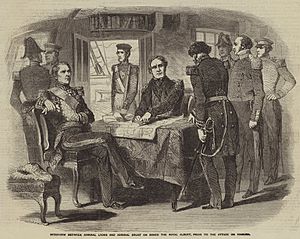
An Unexpected Stop
In late December 1855, the Royal Albert had a problem. While sailing from the Crimea to Malta, she started leaking! The crew had to quickly beach the ship at San Nicholas, on the island of Kea in Greece. Luckily, she was later refloated and taken to Malta for repairs.
Later Years
After her repairs, the Royal Albert continued her service.
- More Commanders: From April 1857 to August 1858, Captain Francis Egerton was in charge.
- Channel Squadron: From August 1858 to October 1859, Captain Edward Bridges Rice commanded her. She was part of the Channel Squadron, a group of ships protecting the English Channel. Rear-Admiral Charles Fremantle led this squadron.
- Final Commander: Her last captain was Henry James Lacon, from October 1859 until she was taken out of service in January 1861.
The End of an Era
The Royal Albert was officially taken out of service in 1861. Many years later, in 1884, she was sold to a company called Castle. They broke her up for parts in Charlton. This was a common end for old warships.
